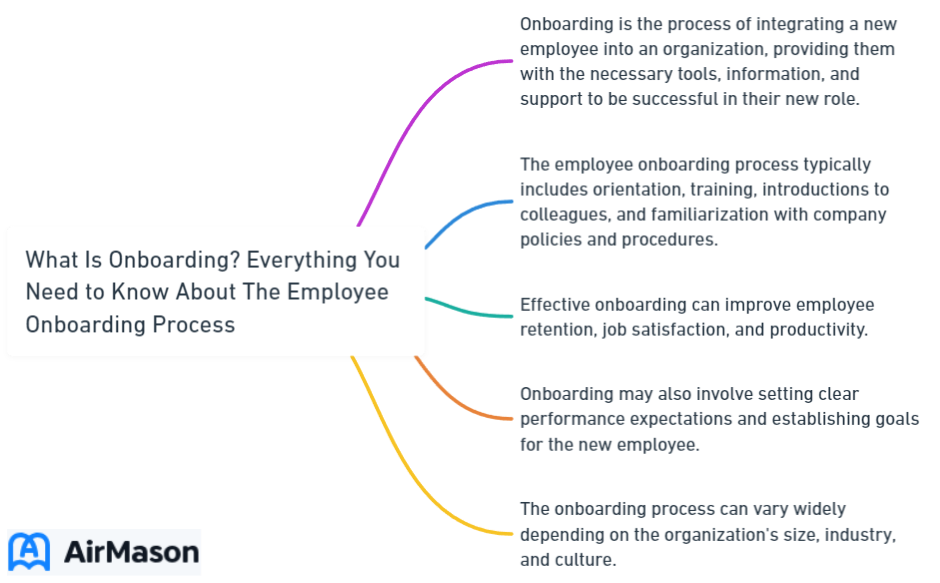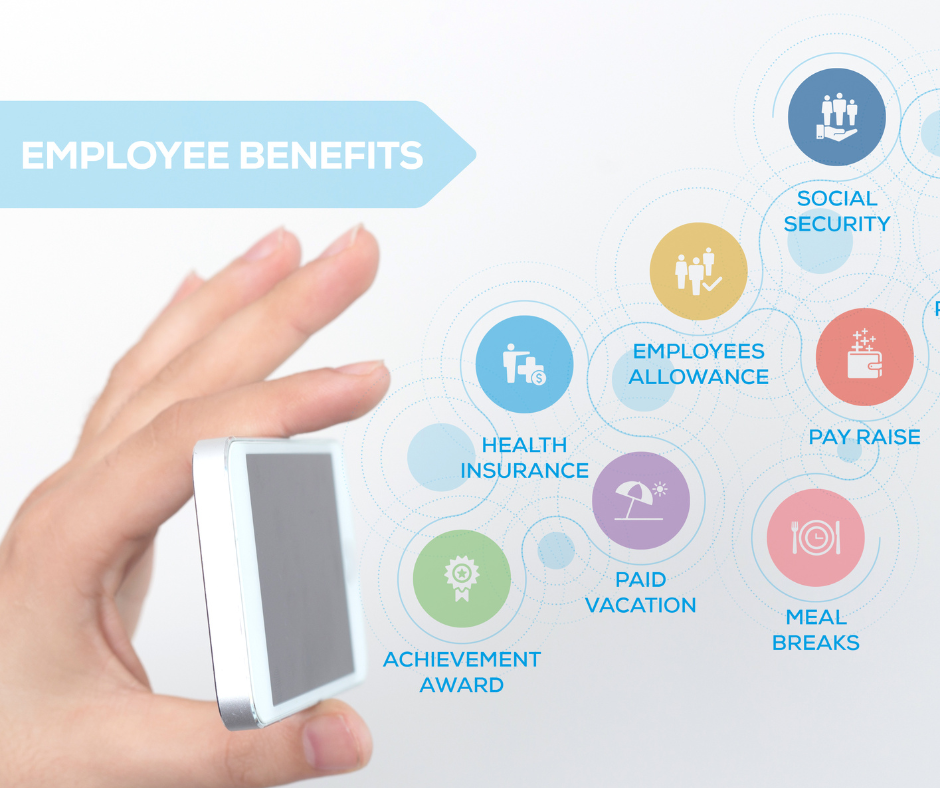![What is.onboarding Everything You Need to Know About Employee Onboarding Process [2023]](https://images.blog.airmason.com/wp-content/uploads/2023/10/What-is.onboarding-Everything-You-Need-to-Know-About-Employee-Onboarding-Process-2023.png)
Are you struggling to retain new hires and maximize their productivity? The onboarding process could be the missing piece of the puzzle. In this blog post, we’ll explore the ins and outs of employee onboarding, its importance, best practices, and how to adapt it for the future. Buckle up and get ready for an insightful journey that will transform your onboarding approach and boost your organization’s success. But first, let’s answer the question: what is onboarding, or more specifically, “what is.onboarding”?
Key Takeaways
- Onboarding is the process of introducing new employees to their roles, corporate culture and expectations.
- Best practices for employee onboarding such as personalized plans, transparent communication and automation can help ensure a positive experience.
- Organizations should adapt onboarding processes regularly to align with evolving workforce needs and embrace new technologies like VR/AR.
Understanding Employee Onboarding
The onboarding process involves integrating new employees into the workplace through measures like orientation, training, and ongoing support, thereby ensuring a successful transition. The recruitment process begins when a prospective employee accepts the offer letter. They then officially become part of the organization. The employee onboarding workflow is a sequence of predefined steps that introduce new hires to the organization’s environment and culture.
A well-structured onboarding program profoundly influences an employee’s experience and their integration into the company. The duration of the employee onboarding process varies, typically ranging from ninety days to twelve months. In short, onboarding plays a pivotal role in the long-term success of both the employee and the organization.

The Purpose of Onboarding
The goal of onboarding is to:
- Familiarize new employees with their roles, corporate culture, and requirements
- Foster a welcoming environment
- Expedite their productivity
- Ensure that new hires are equipped with all the requisite information to operate within the organization
- Create a pleasant and secure atmosphere where everyone feels supported and embraced.
An onboarding checklist is crafted to highlight the critical aspects of introducing a new employee, thus assisting them in acclimating to their new role and environment. A fully optimized onboarding experience ensures that a new hire is adequately prepared to fulfill their role and is enthusiastic about joining the team.
Key Components of Onboarding
Onboarding covers multiple elements like:
- Pre-boarding
- Orientation
- Training
- Continued support
The onboarding process advances in a sequence involving pre-boarding, orientation, training, and continuous support.
Interdepartmental collaboration during onboarding is essential to ensure a smooth transition for new employees and instill a sense of belonging. HR staff may solicit the aid of team members from other departments to adorn the new employee’s cubicle, arrange individual welcome meetings, and organize an orientation session.
The Employee Onboarding Journey

The onboarding journey unfolds through various stages:
- Pre-boarding
- First day and orientation
- Training and skill development
- Continuous support and check-ins
Each of these stages plays a vital role in ensuring a smooth and successful integration of the new employee into the organization, covering the entire process.
The first day of employee orientation typically involves activities such as a welcome presentation, a premises tour, and one-on-one meetings with managers and peers. For optimal onboarding effectiveness, extending the program to at least 90 days, offering in-depth training and skill development opportunities, and assigning mentors to new hires is advisable.
Pre-Boarding
Pre-boarding involves engaging with new hires before their start date, providing them with necessary information, and priming the team for their integration. This stage ensures that new employees feel welcomed and appreciated even before they officially join the company.
A pre-boarding email should contain important details such as:
- Dates
- Times
- Locations
- Relevant contact info
Instructions regarding what to bring and the dress code should also be included. Notifying the current team of a new recruit prior to their arrival can assist them in preparing for the new team member and greeting them warmly.
First Day and Orientation
The first day and orientation should foster a welcoming environment, allow new hires to meet the team, and offer a snapshot of the company culture and expectations. It is important to familiarize the employee with their new work area, provide them with the necessary equipment and access codes, and assist them in setting up their desk/work area.
A welcome packet should be provided to new employees, including:
- The employee handbook
- Benefit information
- Policies and procedures
- Orientation schedule
- An orientation checklist to ensure a smooth transition
These efforts will help the employee feel valued and supported from day one.
Training and Skill Development
Training and skill development should cater to each employee’s unique needs, emphasizing both role-specific skills and broader company competencies. A company can ascertain the individual training requirements of each employee during onboarding by:
- Defining organizational and department objectives
- Evaluating employee performance
- Soliciting employee feedback
- Executing training needs analysis
- Establishing clear expectations
Role-specific skills are of paramount importance in an employee’s onboarding process, as they provide the requisite knowledge and abilities for the employee to perform optimally in their specific role. These skills are tailored to the requirements and responsibilities of the position, enabling the employee to carry out their job proficiently and contribute to the overall success of the organization.
Ongoing Support and Check-Ins
Continuous support and check-ins aim to make new employees feel valued, address any concerns, and ensure progress towards performance objectives. Regular check-ins can provide new employees with a sense of worth, address any worries, and guarantee they are progressing towards meeting performance objectives.
Providing continual support and feedback throughout the first year may facilitate improved retention and job satisfaction for new employees. It is likely that employees who perceive their supervisors to be concerned about their welfare and invested in their development will be more productive and remain with the company.
Employee Onboarding: Setting the Stage for Success
Employee onboarding is a critical process that lays the foundation for a successful and productive work relationship. It encompasses the activities and procedures involved in integrating new hires into an organization, ensuring they feel welcomed, informed, and prepared for their roles. Effective employee onboarding goes beyond just paperwork; it’s about creating a positive and engaging experience for the new employee. The first few days and weeks at a new job are pivotal, as they set the tone for an individual’s overall job satisfaction, retention, and performance. A well-structured onboarding program not only helps employees adapt to their new environment but also fosters a sense of belonging, aligns them with the company’s culture and values, and provides them with the tools and knowledge they need to excel in their positions.
Benefits of Effective Employee Onboarding

Effective onboarding leads to increased employee retention, accelerated productivity, and a fortified company culture. Studies indicate that organizations with an effective onboarding process enhance new hire retention by 82 percent. Furthermore, companies that possess effective onboarding programs encounter decreased employee turnover, augmented business stability, and augmented productivity.
Effective onboarding also contributes to a company’s culture by:
- Facilitating employee socialization
- Fostering a sense of belonging
- Introducing new hires to the organizational culture
- Assisting them in comprehending their roles
In essence, an effective onboarding process is vital for the long-term success of both the employee and the organization.
Remote and In-Person Onboarding
Both remote and in-person onboarding should follow similar procedures, incorporating adjustments to tackle the unique challenges of remote work. Unique difficulties associated with remote onboarding versus in-person onboarding include:
- Lack of physical interaction and engagement
- The challenge of crafting a reliable virtual onboarding process
- Minimal chances to foster relationships
- Issues with effective communication and instruction remotely
Technological tools that are advantageous in aiding remote onboarding include:
- Video conferencing software
- Onboarding software
- Intranet
- Learning management system
- HR system
- Communication tools
- Chatbots
- Collaboration platforms like Slack, Teams.cc, and Monday.com
Utilizing these tools can help streamline the onboarding process and improve the overall experience for remote employees.
Best Practices for Employee Onboarding
The overall onboarding experience can be enhanced by implementing best practices such as:
- Personalized onboarding plans
- Transparent communication
- A structured onboarding timeline
- Automation and upskilling
There is an increased emphasis on the onboarding experience.
Following these best practices will not only ensure a positive onboarding experience for new hires but also help organizations stay ahead of the competition and adapt to the ever-evolving workforce landscape. By continually refining the onboarding process and incorporating best practices, companies can effectively integrate new employees and set them up for long-term success.
Onboarding Process
The onboarding process is a critical phase in any organization, setting the tone for a new employee’s experience and integration into the company culture. It encompasses a series of structured activities and orientations designed to familiarize new hires with their roles, responsibilities, and the broader organizational environment. A well-organized onboarding process not only ensures that employees understand their job functions but also helps them acclimate to the company’s values and goals. Moreover, it provides an avenue for new hires to establish connections with their colleagues, supervisors, and other stakeholders. By systematically introducing employees to the company’s policies, procedures, and tools, the onboarding process lays a strong foundation for their success and productivity in their new roles. It is a dynamic and adaptable procedure that may evolve with the changing needs of the organization, making it an essential component of talent acquisition and retention strategies.
Automating the Onboarding Process
Automation can streamline the onboarding process, boost efficiency, and ensure consistency across the organization. Onboarding software is a tool that facilitates the automation of the onboarding process, thereby enabling Human Resources teams to effectively manage and monitor the progress of new employees.
Utilizing onboarding software can provide the following benefits:
- Reduce the workload of HR personnel
- Offer a captivating and optimized experience for new employees
- Automate the onboarding process
- Ensure a consistent, positive onboarding experience
- Free up valuable resources to focus on more strategic initiatives.
Measuring Onboarding Success

Monitoring key onboarding metrics enables the assessment of the process’s effectiveness and identification of areas for improvement. Metrics such as:
- Costs
- Engagement levels
- Training costs
- Outcomes for new employees
- Succession management success rates
- Retention
These metrics can provide valuable insights into the success of your onboarding program.
By monitoring these metrics, organizations can identify trends and patterns, pinpoint areas for improvement, and make data-driven decisions to enhance the onboarding process. Continually measuring and analyzing onboarding success is crucial for ensuring the long-term effectiveness of the program and driving positive outcomes for both employees and the organization.
Adapting Your Onboarding Process for the Future

For long-term success, regularly updating and adapting your onboarding process to align with the evolving workforce needs and expectations is essential. Recent developments in employee onboarding include:
- Personalization
- Virtual onboarding
- Pre-boarding
- Peer-to-peer recognition
- Socialization
- Automation
- Flexibility and choice
By staying up-to-date with the latest trends and developments in the onboarding landscape, organizations can ensure that their onboarding processes remain relevant and effective in the face of changing workforce dynamics. Adapting to the future of work and embracing new technologies, such as virtual reality (VR) and augmented reality (AR), can further enhance the onboarding experience and set your organization up for continued success.
Onboarding Document: A Comprehensive Guide for Seamless Integration
An onboarding document serves as a cornerstone for new employees entering a company. This crucial resource encompasses a range of information vital for a seamless integration into the organization. The onboarding document is meticulously crafted to provide a clear roadmap, outlining the company’s culture, policies, and procedures. It acts as a reference point for employees to familiarize themselves with the organizational structure, team members, and the tools and resources available to them.
This document typically includes an introduction to the company’s mission, vision, and values, giving new hires an insight into the overarching goals and ethos of the organization. Additionally, it covers essential HR details, such as benefits packages, company policies, and compliance guidelines, ensuring that employees are well-informed and compliant from day one. The onboarding document may also contain information about the employee’s specific role, responsibilities, and expectations, offering a clear understanding of their position within the company.
Summary
In conclusion, a well-designed and effective employee onboarding process is essential for ensuring the successful integration of new hires into the organization. By understanding the importance of onboarding, implementing best practices, automating the process, measuring success, and adapting to the future, organizations can foster a positive onboarding experience that leads to increased employee retention, faster productivity, and a stronger company culture. Invest in your onboarding program and watch your organization soar to new heights.
Frequently Asked Questions
What does onboarding mean in a job?
Onboarding is a comprehensive process that introduces a new hire to the organizational culture and ensures they understand their job requirements, gain necessary knowledge, skills, and behaviors, become productive members of the organization, and acquire an understanding of the company’s structure, culture, mission, and values.
What is in the onboarding process?
Onboarding is the process of integrating new hires into the organization, which includes activities such as completing paperwork, setting up computer access and making social introductions. It also involves an initial new-hire orientation that allows employees to learn about the organization’s structure, culture, vision, mission and values.
Does onboarding mean you’re hired?
Onboarding is typically the process of introducing a newly hired employee into an organization, and usually when you accept and sign the job offer letter and kick off the onboarding process, you’re hired for the position. However, many jobs have probationary periods that can last up to 12 months, so you could still be released during that time.
What is the difference between onboarding and orientation?
Onboarding is a longer process that encompasses orientation, which is the initial introduction to a new environment for new hires.
How long does the employee onboarding process typically last?
Onboarding for new employees typically takes between three and twelve months.
